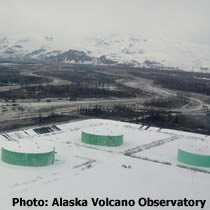
 |
|
|
April 30, 2009 Additional oil successfully removed from Drift RiverFrom a Coast Guard press release:The potential threat posed by the stored oil at the Drift River Oil Terminal has been reduced approximately 93 percent. The Chevron-flagged tanker Mississippi Voyager completed an out load of oil and water from the terminal's tanks and departed for a refinery in Hawaii at 6:30 a.m. Thursday. "We have effectively removed the majority of the oil at the facility," said Gary Folley, state on scene coordinator, unified command. "Thus we have significantly reduced the potential threat to Cook Inlet." 
The unified command will continue to monitor the facility and discuss the situation on at least a weekly basis until information is received from the Alaska Volcano Observatory indicating the volcano has entered a dormant period. About 60 percent of the initial 6.2 million gallons (148,000 barrels) of the stored oil in tanks 1 and 2 at the Drift River Terminal was removed in the April 6 draw down. That volume of oil has been further reduced to about 7 percent of the initial 6.2 million gallons. At least 5,040,000 gallons (120,000 barrels) of water was pushed back into the tanks from the Mississippi Voyager to ensure the tanks do not become buoyant in the event of a flood. "The tanker was accompanied by the tug Vigilant. The bridge of the tanker was manned 24 hours a day and the engines remained on stand by at all times during the transfer," said Capt. Mark Hamilton, federal on-scene coordinator, unified command. "We took great care in this process. As a precaution we reinstituted the same measures we used previously with the Seabulk Arctic transfer in early April." Repairs and clean-up of the facility continues. About 3,000 feet of the existing runway has been cleared to allow for diesel fuel deliveries by fixed wing aircraft. The fuel is used to run generators and heavy equipment at the facility. A plan to clean the tanks is being developed by Cook Inlet Pipe Line. "Once the volcano is determined to be dormant and we can put people safely on the ground for an extended period of time we will use vacuum trucks and hand methods to thoroughly clean the tanks," said Rod Ficken, vice president Cook Inlet Pipeline Company, unified command. Cook Inlet Pipe Line in conjunction with Chevron and the upstream producers are considering options for future operations of the facility. The Coast Guard and the State of Alaska will ensure that whatever decision the companies make they continue to operate within the regulations for oil operations and transfers. Redoubt Volcano continues to produce emissions of steam, volcanic gases and minor amounts of ash, according to the Alaska Volcano Observatory. © AlaskaReport.com All Rights Reserved. |
|